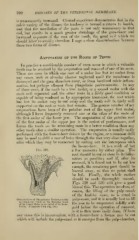Page 980 - My FlipBook
P. 980
990 DISEASES OF THE PERIDENTAL MEMBRANE.
is unnecessarily increased. Clinical experience demonstrates that in the
calcic variety of the disease the tendency is toward a return to health,
and that the mutilation of the parts is not only unnecessary to that
end, but results in a much greater shrinkage of the gum-tissue and
increased exposure of the root of the tooth, the great evil which we
should labor to avoid ; therefore I urge a close discrimination between
these two forms of disease.
Amputation op the Roots of Teeth.
In practice a considerable number of cases occur in which a valuable
tooth can be retained by the amputation and removal of one of its roots.
These are cases in which one root of a molar has lost its socket from
any cause, such as alveolar abscess neglected until the membrane is
destroyed and the gum shrunken away, or from localized calcic inflam-
mation, but perhaps oftenest fi-om phagedenic pericementitis. In any
of these cases, if the tooth be a first molar, or a second molar with the
roots well separated and the other roots in a fairly good condition or
capable of being rendered so by appropriate treatment, the root which
has lost its socket may be cut away and the tooth will be ftiirly well
supported on the root or roots that remain. The greater number of my
amputations have been of the palatine root of the upper first molar,
although I have frequently removed one or the other of the roots of
the first molar of the lower jaw. The amputation of the palatine root
of the first molar of the upper jaw is the easiest of performance, and
leaves the tooth on its remaining roots in a better condition than any
other tooth after a similar operation. The amputation is usually easily
performed with the fissure-burr driven by the engine, or a common drill
may be used to drill a row of holes through the root very close together,
after which they may be connected by cutting out the interspaces with
the fissure-burr. It is a work of but
Fig. 529. a few moments by either plan. The
root should be cut as close to its bifur-
cation as possible ; and if, after its
removal, it is found not to be cut low
enough, the remaining part should be
burred away, so that no point shall
be left. Finally, the whole surface
should be made thoroughly smooth.
Figs. 529 and 530 will give a good
idea of this. The operation involves, of
course, the filling of the jndp-canals
of the healthy roots, as is usual in
Chronic Case of Phagedenic Pericementitis ]>ulp-cases, and it is usually best to fill
in wliicli tlu! whole of the Palatine Hoot the root to be amputated solidly with
of an Upper Molar is denuded of its Mem-
brane. (Compare with Kig. 530.)
gold before the operation of removal,
as it IS then more easily done. If from
any cause this is inconvenient, with a fissure-burr a fissure may be cut
which will include the pulp-canal as it emerges from the pulp-chamber,


